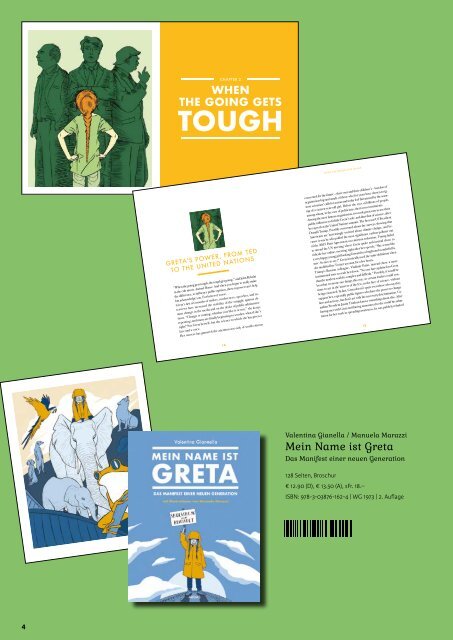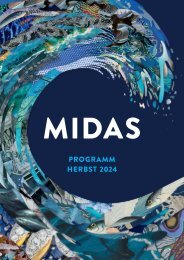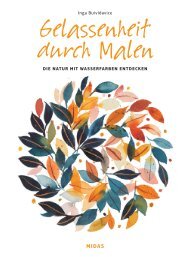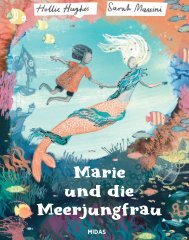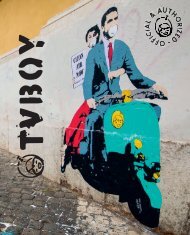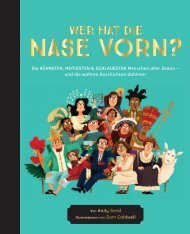Programm Midas Kinderbuch Frühjahr 2020
Neuerscheinungen Midas Kinderbuch im Frühjahr 2020: Atlas der Städte (Colombo/Faccioli), Helden-Atlas (Colombo/Faccioli), Green Nation Revolution (Valentina Giannella), Mein Name ist Greta (Valentina Giannella), Iggy Peck, Architekt (Andrea Beaty, David Roberts), Anna und die Bücherbande (Dupin/Desprès), Voll auf die Nuss (Collet/Chebret), Der Lesewolf (Carboneill/Derullieux), Der hungrige Bär (Auzary-Luton/Derullieux), Das Ohr (Piret Raud), Die Stadt der Tiere (Joan Negrescolor) Der Krieg (José Letria und André Letria), , Der grüne Riese (Katie Cottle), Darwins grosse Reise (Jake Williams), Die Welt der Bilder für Kinder (David Hockney, Martin Gayford), Vincents Sternennacht (Michael Bird), Eine Reise durch die Kunst (Aaron Rosen), Ich bin heute (Madalena Moniz), Wenn ich ein Buch wäre... (José Letria und André Letria), Was macht das Horn im Wald? (Peter Stangel), Leo, Hanna und die Werbehexen (Karin Burger und May Aurin), Ein Bär namens MUR (Kaisa Happonen und Anne Vasko), MUR und die Blaubeere (Kaisa Happonen und Anne Vasko), ART PLAY (Marion Deuchars), Malen und Zeichnen wie die grossen Künstler (Marion Deuchars).
Neuerscheinungen Midas Kinderbuch im Frühjahr 2020: Atlas der Städte (Colombo/Faccioli), Helden-Atlas (Colombo/Faccioli), Green Nation Revolution (Valentina Giannella), Mein Name ist Greta (Valentina Giannella), Iggy Peck, Architekt (Andrea Beaty, David Roberts), Anna und die Bücherbande (Dupin/Desprès), Voll auf die Nuss (Collet/Chebret), Der Lesewolf (Carboneill/Derullieux), Der hungrige Bär (Auzary-Luton/Derullieux), Das Ohr (Piret Raud), Die Stadt der Tiere (Joan Negrescolor) Der Krieg (José Letria und André Letria), , Der grüne Riese (Katie Cottle), Darwins grosse Reise (Jake Williams), Die Welt der Bilder für Kinder (David Hockney, Martin Gayford), Vincents Sternennacht (Michael Bird), Eine Reise durch die Kunst (Aaron Rosen), Ich bin heute (Madalena Moniz), Wenn ich ein Buch wäre... (José Letria und André Letria), Was macht das Horn im Wald? (Peter Stangel), Leo, Hanna und die Werbehexen (Karin Burger und May Aurin), Ein Bär namens MUR (Kaisa Happonen und Anne Vasko), MUR und die Blaubeere (Kaisa Happonen und Anne Vasko), ART PLAY (Marion Deuchars), Malen und Zeichnen wie die grossen Künstler (Marion Deuchars).
Erfolgreiche ePaper selbst erstellen
Machen Sie aus Ihren PDF Publikationen ein blätterbares Flipbook mit unserer einzigartigen Google optimierten e-Paper Software.
CHAPTER 2<br />
WHEN<br />
THE GOING GETS<br />
TOUGH<br />
WHEN THE GOING GETS TOUGH<br />
GRETA’S POWER, FROM TED<br />
TO THE UNITED NATIONS<br />
“When the going gets tough, the tough get going,” said John Belushi<br />
in the cult movie Animal House. And when you begin to really make<br />
the difference, to influence public opinion, those in power can’t help<br />
but acknowledge you. For better or worse.<br />
Greta’s last six months of strikes, conferences, speeches, and interviews<br />
have increased the visibility of the struggle against climate<br />
change in the media and on the desks of public administrations.<br />
“Change is coming, whether you like it or not,” she keeps<br />
repeating, and many are finally beginning to wonder: what if she’s<br />
right? Not Greta herself, but the science to which she has given a<br />
face and a voice.<br />
Her success has garnered the attention not only of world citizens<br />
13<br />
concerned for the future – their own and their children’s – but also of<br />
negationists big and small, of those who for years have chosen to ignore<br />
scientists’ calls for action and today feel threatened by the warning<br />
of a sixteen-year-old girl. Before the eyes of billions of people,<br />
among whom, in the case of politicians, their own constituents.<br />
Among the most famous negationists, two took great care to use their<br />
public influence to belittle Greta’s role, and thus that of science, after<br />
her speech at the United Nations summit. The first was US President<br />
Donald Trump. Possibly concerned about the surveys showing that<br />
Americans are increasingly worried about climate change, and because<br />
it was he who pulled the most significant carbon polluter out<br />
of the 2015 Paris Agreement on emission reduction, Trump failed<br />
to attend the UN meeting where Greta spoke and instead chose to<br />
ridicule her online, tweeting right after her speech, “She seems like<br />
a very happy young girl looking forward to a bright and wonderful future.<br />
So nice to see!” Greta ironically used the same definition when<br />
she modified her Twitter account for a few hours.<br />
Trump’s Russian colleague, Vladimir Putin, instead chose a more<br />
institutional tone to scale her down, “No one has explained to Greta<br />
that the modern world is complex and difficult.” Possibly, it would be<br />
best that everyone saw things this way, so certain leaders could continue<br />
to act in the interest of the few, in the face of science, without<br />
being contested. In fact, Greta doesn’t spare even those who say they<br />
support her, especially public figures who have the power to change<br />
laws and actions, but don’t act with the necessary determination. Canadian<br />
President Justin Trudeau knows something about this. After<br />
having met with Greta and having announced to the world his admiration<br />
for her work in spreading awareness, he was publicly rebuked<br />
15<br />
14<br />
MEIN NAME IST GRETA<br />
KAPITEL 12<br />
WAS IST<br />
BIODIVERSITÄT<br />
Valentina Gianella / Manuela Marazzi<br />
Mein Name ist Greta<br />
Das Manifest einer neuen Generation<br />
128 Seiten, Broschur<br />
€ 12.90 (D), € 13.50 (A), sFr. 18.–<br />
ISBN: 978-3-03876-162-4 | WG 1973 | 2. Auflage<br />
83<br />
4


